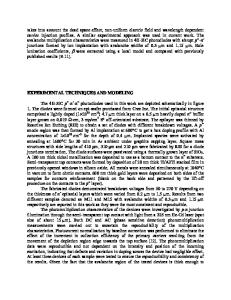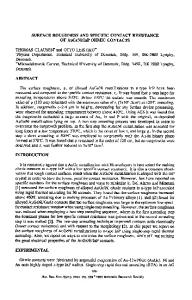Contact resistivity of Al/Ti ohmic contacts on p-type ion implanted 4H- and 6H-SiC.
- PDF / 77,350 Bytes
- 6 Pages / 612 x 792 pts (letter) Page_size
- 12 Downloads / 347 Views
K6.2.1
Contact resistivity of Al/Ti ohmic contacts on p-type ion implanted 4H- and 6H-SiC. Roberta Nipoti, Francesco Moscatelli1, Andrea Scorzoni1, Antonella Poggi, Gian Carlo Cardinali, Mihai Lazar2, Christophe Raynaud2, Dominique Planson2, Marie-Laure Locatelli2 and Jean-Pierre Chante2 CNR- IMM Sezione di Bologna, via Gobetti 101, 40129 Bologna 1 Dipartimento d’Ingegneria Elettronica e dell’Informazione, Università di Perugia, via G. Duranti 93, 06125 Perugia 2 CEGELY (UMR CNRS n°5005), Bât. Leonard de Vinci, INSA de Lyon, 20, Av. A. Einstein, F69621, Villeurbanne Cdx France ABSTRACT Al-Ti alloys with 72 wt% Al were employed for the realisation of ohmic contacts on 4×1019 cm-3 p-type ion implanted 4H- and 6H-SiC samples. Contact resistivity characterisations by TLM measurements were done at wafer level in the temperature range 28-290°C. Analysis of the TLM measurements took into account current crowding at the metal pads. More than half of the evaluated contact resistivity reached the minimum value detectable by the used TLM devices, that was slightly higher than 1×10-6 Ωcm2. Above this limit value, contact resistivity decreased for increasing temperature and was spread over a few decades. The maximum contact resistivity at 28°C was 2×10-4 Ωcm2, which changed to 5×10-6 Ωcm2 at 290°C. The thermal behaviour of these TLM structures featured thermionic-field emission conduction. INTRODUCTION Al-Ti alloys have been subjects of several electrical, chemical and physical investigations aimed at making ohmic contacts on p-type SiC [1]. The alloy with the 70 wt% Al was found to give the more reproducible specific contact resistivity ρc after vacuum annealing at 1000°C for 2 min. These ρc values ranged from 1.5×10-4 Ωcm2 to 9.5×10-6 Ωcm2 for doping concentration ranging from 7×1018 cm-3 to 1.3×1019 cm-3, respectively, independently of the 4H- or 6H-SiC polytype [2]. Moreover, the lowest ρc values were found to be independent of the alloy ratio [2, 3]. These studies featured as grown SiC epilayers, mesa etching, Al-Ti sintered targets of the desired weight ratio and lift off technology to define the metal pattern for the ρc evaluation. The purpose of this work was to transfer the 70 wt% Al recipe [2] to p-type ion implanted 4H- and 6H-SiC specimens. Due to technological constraints some steps were modified. In particular, single element targets were used and the layer thickness ratio was chosen in such a way that the desired Al/Ti weight ratio were obtained. The metal patterns were defined by chemical etching. Different gases in the annealing ambient were studied, namely high purity Ar and vacuum. Transmission Line Method (TLM) was used to evaluate the ρc of these Al-Ti alloyed contacts. In particular, the resistance measurements on TLM structures were analysed accounting for two-dimensional (2D) and three-dimensional (3D) current flow. EXPERIMENTAL 8° off-axis 4H-SiC and on-axis 6H-SiC, n-type wafers supplied by CREE were used for this study. Almost box shaped doping profiles were made at the sample surface via
K6.2.2
mu
Data Loading...











